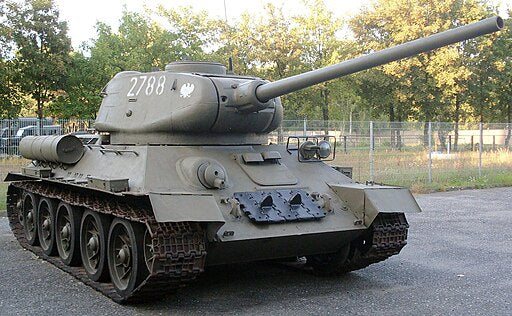World War II’s sprawling battlefields were not merely sites of intense ideological and military skirmishes but also pivotal arenas for pioneering technological innovations. Leading the charge in this mechanized warfare were formidable armored titans, particularly the Soviet T-34 and the German Tiger tanks, each epitomizing the zenith of armored combat. This blog post thoroughly examines these iconic tanks’ performance and strategic implications, offering a detailed assessment of their capabilities and enduring impact on military history.
Engineering Excellence: A Tale of Two Designs
The T-34 stood as a paragon of Soviet engineering—practical, efficient, and relentlessly effective. It skillfully married simplicity with functionality, embodying the ideal of streamlined design and robust performance. Its revolutionary sloped armor provided superior ballistic protection and redefined tank design, setting a benchmark that would influence future generations of armored vehicles. Its sloped armor, a revolutionary design concept at the time, significantly increased the deflection of incoming fire. Coupled with a robust diesel engine, the T-34 enjoyed greater mobility and a lower risk of catching fire than its contemporaries. This made it not only a nightmare in combat but also a vehicle that could be produced en masse, ensuring the Red Army could replace losses quickly and maintain pressure on the Eastern Front.
In stark contrast to the T-34’s emphasis on simplicity, the Tiger Tank was a testament to the sophistication of German engineering. It featured robust armor and an 88mm gun renowned for its formidable long-range capabilities, instilling fear across the battlefield as it decimated enemy tanks from afar. However, its superior firepower came with the drawbacks of high production costs and mechanical complexity. The Tiger’s heavyweight strained its engines and made it cumbersome on softer ground, limiting its operational range and requiring frequent maintenance.
Battle-Tested: Performance in Combat
On the battlefield, the Tiger Tank often held the advantage in head-to-head engagements. Its powerful main gun could dispatch most Allied tanks before they were close enough to retaliate. This capability made the Tiger a formidable opponent in the open fields of Europe, where engagement ranges were long.
However, the T-34 thrived in the diverse environments of the Eastern Front—from the dense forests and urban areas to the muddy springs and freezing winters. The T-34’s agility and dependability proved pivotal, enabling Soviet forces to execute deft flanking maneuvers and penetrate weaknesses in German defenses. Additionally, its capacity to operate effectively under harsh conditions with minimal logistical support made it an invaluable asset during significant offensives, such as the Battle of Kursk.
A Legacy of War: Historical Impact
The effectiveness of a tank goes beyond mere battlefield performance; it also hinges on its impact on the broader strategic dynamics of the war. In this context, the T-34’s role was undeniably crucial, significantly shaping the overall direction of the conflict. Its production scalability meant that the Soviets could field an overwhelming number of tanks, a critical factor in their eventual steamrolling of the Nazi war machine. By the war’s end, over 80,000 T-34s had been produced, dwarfing the production numbers of the Tiger.
While the Tiger earned a reputation as a fearsome killer, its psychological impact on enemies was offset by its rarity and maintenance issues. Known to cause ‘Tigerphobia’ among Allied tank crews, it was nevertheless too scarce to change the war’s outcome independently.
Conclusion: Defining “Better”
In the duel between the T-34 and the Tiger Tank, “better” depends significantly on how we view their contributions. If we measure by firepower and direct combat superiority, the Tiger might edge out its competitor. However, when considering production efficiency, reliability under diverse conditions, and overall impact on the war effort, the T-34 emerges as the more decisive force.
Both tanks have left unforgettable marks on military history, each excelling in its own way and coming to symbolize their respective nations’ industrial and military capabilities during one of history’s darkest periods. The debate over which tank was better continues to be a fascinating reflection of the complex interplay between technology, strategy, and historical circumstances.
For more insights into the T-34-85 Soviet Tank and other important military aircraft, visit Aces In Action. Here, you’ll find an amazing piece of artwork by Craig Tinder titled “Konev’s Approach to Berlin” that illustrates a T-34 of the Soviet Army from Ivan Konev’s First Ukranian Front as they near the outskirts of Berlin in April 1945. The limited edition canvas print even includes a piece of a fragment of brass shell casing from a T-34-85 from the First Ukranian Front near Berlin, making it a unique piece of history!
Konev’s Approach to Berlin – T-34-85 Soviet Tank by Craig Tinder
22 April 1945 – T-34 tanks from the Soviet Union’s 1st Ukrainian Front reached the southern outskirts of Berlin. Led by Ivan Konev, the 1st Ukrainian Front was one of the most powerful Soviet forces aimed to capture Berlin and end the war. Despite Stalin’s plan for Berlin to fall on this date, coinciding with Lenin’s birthday, Konev’s troops were still fighting on the city’s periphery. By the end of the day, Soviet forces had reached the Teltow Canal inside Berlin.
To purchase or see similar items, visit here.
Commissioned by Museums, Treasured by Collectors





Share:
The Flying Tigers: A Comprehensive Overview of Their Remarkable Combat Success
Aerial Domination: American WWII Fighter Aircraft Analysis